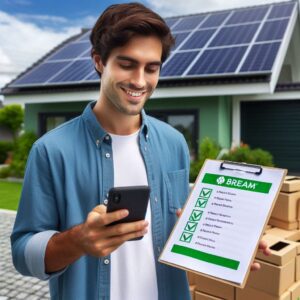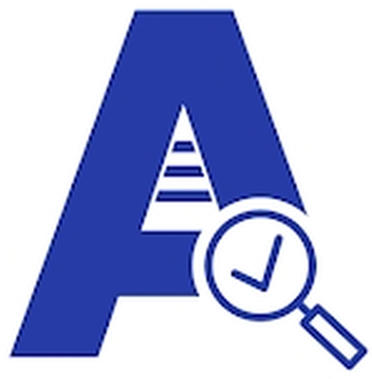BREEAM Checklist
BREEAM Checklist using eAuditor Audits & Inspections can help track compliance with the BREEAM (Building Research Establishment Environmental Assessment Method) certification process. BREEAM focuses on sustainable construction and operational practices, covering categories like energy, health, materials, waste, and more. Here’s how you can structure a BREEAM checklist within eAuditor Audits & Inspections.

BREEAM Checklist Template
1. General Project Information
- Project Name:
- Project Location:
- Assessor Name:
- Project Manager:
- BREEAM Certification Level Targeted (e.g., Pass, Good, Very Good, Excellent, Outstanding):
- Assessment Stage (Design/Construction/Post-Construction):
- Date of Assessment:
2. Management (Man)
- 2.1. Sustainable Procurement Plan:
- Is there a project-specific sustainability plan in place?
- Has the BREEAM assessment criteria been incorporated into the procurement process?
- 2.2. Life Cycle Costing (LCC):
- Has a full life cycle costing been conducted?
- 2.3. Design Responsibility:
- Have the roles and responsibilities for sustainability been clearly defined?
3. Health and Wellbeing (Hea)
- 3.1. Daylighting:
- Have minimum daylighting levels been achieved in key areas?
- Does building use light controls to maximize energy efficiency?
- 3.2. Indoor Air Quality (IAQ):
- Does building assess indoor air quality?
- Are ventilation systems installed according to design?
- 3.3. Thermal Comfort:
- Has a thermal comfort analysis been performed?
- Are adaptive comfort systems in place?
4. Energy (Ene)
- 4.1. Energy Efficiency:
- Does the building exceed national minimum standards for energy performance?
- Is energy metering installed for key areas of energy use?
- 4.2. Renewable Energy:
- Are renewable energy systems in place (e.g., solar panels, wind turbines)?
- What percentage of the building’s energy consumption is from renewables?
- 4.3. Low and Zero Carbon Technologies:
- Has the use of low/zero carbon technologies been considered?
5. Transport (Tra)
- 5.1. Public Transport Accessibility:
- Is the building accessible by public transport?
- Have safe pedestrian and cycling routes been provided?
- 5.2. Parking and Low Emission Vehicles:
- Is there parking for low-emission vehicles and bicycles?
- 5.3. Travel Plan:
- Is a sustainable travel plan in place?


6. Water (Wat)
- 6.1. Water Efficiency:
- Does the building incorporate water-saving fixtures (e.g., low-flow taps, dual-flush toilets)?
- Is a greywater or rainwater harvesting system installed?
- 6.2. Water Monitoring:
- Are there water meters to monitor consumption?
- Are leak detection systems in place?
- 6.3. Efficient Irrigation:
- Are irrigation systems water-efficient, or is xeriscaping used?
7. Materials (Mat)
- 7.1. Material Specification:
- Are building materials responsibly sourced (e.g., FSC-certified wood)?
- Have recycled materials been incorporated into the building’s construction?
- 7.2. Environmental Product Declarations (EPD):
- Are EPDs provided for the key materials?
- 7.3. Durability and Resilience:
- Have durable and low-maintenance materials been used?
8. Waste (Wst)
- 8.1. Construction Waste Management:
- Is a construction waste management plan in place?
- Is there on-site waste segregation?
- 8.2. Operational Waste:
- Are facilities for recycling waste provided for building occupants?
- 8.3. Minimizing Construction Waste:
- Has prefabrication or modular construction been utilized to minimize waste?
9. Land Use and Ecology (LE)
- 9.1. Site Selection:
- Has the project avoided building on ecologically sensitive land?
- Is the site located on previously developed or brownfield land?
- 9.2. Ecological Value:
- Have ecological assessments been conducted pre-construction?
- Are measures in place to enhance the site’s ecological value?
- 9.3. Biodiversity Protection:
- Are strategies in place to protect and improve biodiversity?
10. Pollution (Pol)
- 10.1. Air and Water Pollution:
- Are low-emission heating and cooling systems in use?
- Are measures in place to prevent water pollution (e.g., runoff management)?
- 10.2. Light Pollution:
- Do exterior lighting reduce light pollution?
- 10.3. Noise Pollution:
- Have measures been implemented to minimize noise pollution during and after construction?
11. Innovation (Inn)
- 11.1. Innovative Design Features:
- Are there any unique sustainability innovations that have been incorporated?
- 11.2. Exceeding BREEAM Standards:
- Has the project gone beyond the standard BREEAM requirements in any specific category?
How to Implement BREEAM Checklist in eAuditor Audits & Inspections


- Create Template:
- In eAuditor Audits & Inspections, create a new checklist template or use existing BREEAM Checklist. Each of the BREEAM categories above should be a section in the checklist (e.g., Management, Energy, Health & Wellbeing).
- Add Specific Criteria:
- For each section (e.g., Energy Efficiency, Water Efficiency), add the specific questions as outlined above. Use checkboxes, dropdowns, and multiple-choice fields to track compliance.
- Include Evidence Fields:
- Add fields for attaching evidence such as photos, documents (e.g., certifications, reports), or drawings.
- eAuditor Audits & Inspections allows you to embed PDF documents or images directly into the checklist.
- Use Scores:
- Include a scoring system for each BREEAM category, aligned with the BREEAM points criteria. You can set thresholds for achieving different certification levels (e.g., Excellent, Outstanding).
- Task Assignment:
- Assign tasks to team members based on pending items (e.g., missing documentation or further testing required). eAuditor Audits & Inspections allows task delegation and tracking.
- Generate Reports:
- Use eAuditor Audits & Inspection’s report generation feature to automatically produce PDF or Excel reports summarizing the BREEAM compliance at any stage of the project.
- Integrate Sign-Offs:
- Include signature fields for assessors, project managers, and stakeholders to confirm each stage of the assessment.
BREEAM Checklist helps ensure compliance with BREEAM standards, making the assessment process more streamlined and accessible.
